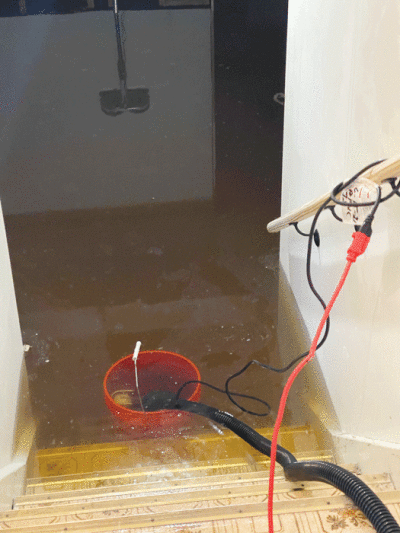
Spring rains and melting snow can raise the risks of flooding — particularly in basements.
Photo provided by Frank Winters
METRO DETROIT — April showers may bring May flowers, but they can also bring severe issues for homeowners.
Spring weather is often very wet, both from snow melting and from an increase in rainfall. These wet conditions mean there are several issues that can crop up for homeowners
“The biggest problems come from big snow melts or rains that cause backups. Basement flooding is a huge problem around this time of year,” said Frank Winters, the owner of Birmingham Plumbing. “Tree roots can also grow into your sewer line, particularly in old houses that have clay pipes. They can even grow into broken PVC pipes and clog the drain.”
“The biggest risks around this time of year include damage to finished basements,” added Rich Piccirilli, the chief operating officer of the Foundation Authority in Clinton Township. “Any kind of flooding is bad. That can destroy possessions, damage the foundation or lead to mold, among other things. You need to pay attention to your home.”
Piccirilli said that homeowners should take this time of year to do a check of their home’s condition as they do their spring cleaning.
“This is the best time of the year to do an exam of their home,” he explained. “Most people in the next 30 days are often outside and doing spring cleaning, so they often notice things. Just look for things; cracks in the brick, windows not closing or opening properly, walls starting to buckle. The soil can expand from the water and affect your home. … You can smell and see mildew. I would always recommend calling a professional to check it out if you see something. It’s better to be safe.”
There are steps homeowners can take to try to avoid such problems. It can be very important to clean a house’s gutters and ensure the downspouts pour the gutters’ water away from the home properly.
“Make sure your downspouts are hooked up and have proper grading away from the house,” said Piccirilli. “Downspouts are important. Make sure gutters are clean and extended away from the house. If it’s pointed away but the grade pours it back toward the house, it still pools around the structure. You want that water away from the house.”
Winters said that making sure the home has a working sump pump and backups that are designed to mitigate or prevent flooding is something homeowners should be doing at least once a year.
“Usually people start identifying problems when water starts showing up,” he said. “Preemptively, you could look for cracks in your basement walls. Make sure your gutters outside aren’t dumping next to the house. Make sure the sump pump and backups are working so they don’t stick when you need them. The backup might not be used for years, so you want to run it periodically to keep it fresh. You might want to make sure your storm trap is clear and inspected.”
Piccirilli advised homeowners to look out for mold but to be very cautious when dealing with it, as some forms can be hazardous to a person’s health.
“In the case of mold or mildew, you can get some household products to clean some light mildew,” he said. “That white effervescence … you can clean that or have a company like ours take care of it. For full-blown black mold, you need to consult a professional company that knows how to deal with that. It can be dangerous.”
Perhaps most importantly, making sure a home has the proper insurance coverage in the event of flooding could save families thousands of dollars in the event of a severe problem caused by spring weather.
“We had a guy who walked in with a basement that was flooded with 3 feet of water and didn’t have insurance,” said Winters. “You always want to make sure you get that insured. We had to replace the sump pump and furnace. He lost pretty much everything he had in that basement.”
Piccirilli said that a little prevention can go a long way. For every $1 invested in disaster mitigation, $6 can be saved in damages and repairs.
“A lot of people are almost scared when they see a crack and are afraid it will be a $20,000 repair,” he said. “Often, it’s not — it’s just a $500 repair. If you can spot these issues soon, it can cost you a lot less money.”
 Publication select ▼
Publication select ▼





















